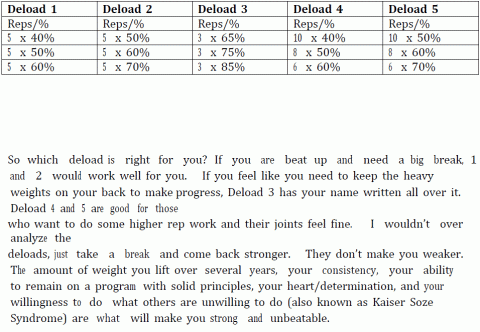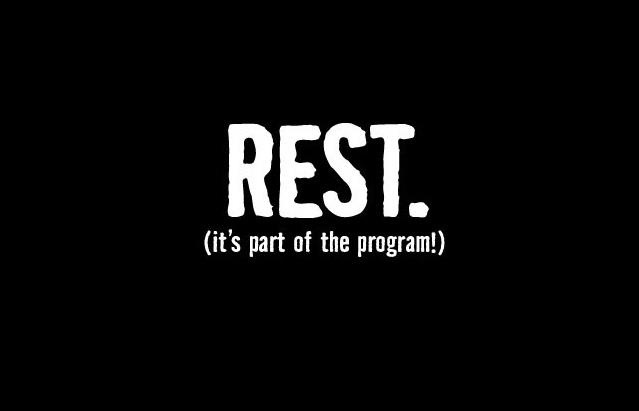Why deload on Wendler?
A deload helps you to protect yourself, get used to a new rep scheme, progress for longer, and stay alert and humble. All of these elements have been incorporated for a reason in Wendler. If you speed it up, you pay the price like I did getting a back injury in my 8 months on Wendler.
What is a deload ?
A deload is the process of stepping back from your normal training schedule and putting your body under less stress. In lifting this is is usually referred to as a deload. In running it is also known as tapering. Usually, you go down in the number of repetitions and weight.
If you put an organism under an unbroken stimulus and strain it will die. Rest / deload weeks are not for wimps, it is for athletes who want to get stronger and faster. Early observations of this were made by Hans Seyle in 1936 in which he created his stress model the GAS or "General Adaptation System". The General Adaptation System splits into three phases as described by Seyle:
- Alarm Stage
- Resistance Stage
- Exhaustion Stage
The alarm stage is a direct reaction to a stimulus in which hormones like adrenalin, noradrenalin and cortisol are being pumped into the body to execute activities that you normally would not do like heavy squatting, deadlifting or bench pressing.
For the resistance stage, the body shifts its resources from fighting off the stressor from the alarm stage, as this has already passed (your squat session has ended), to repair the damage being done. This is the phase, in which muscles grow, neurons adapt and ligaments heal.
If the stress persists, however, you will enter the exhaustion stage. This occurs when the stress has been applied for so long that the body loses to put up resistance. When you enter this stage illness, injuries, and the final stop after too long of continuous exposure is death (squatting for days without resting, eating or drinking to recover).
As a sane person, you want to stay in stages 1 and 2 and avoid stage 3 for long-lasting gains. Zatsiorsky, Rippetoe and Kilgore expanded further on this idea and come up with further models which describe exercise and rest. An often shown graphic to illustrate the correlation between training and rest is the training effect curve.
The training effect curve uses the exposure to certain stress to visualize the effect of training too hard, too easy and training optimal. It has been established by Kenneth H. Cooper, a former airforce colonel, who did a lot of research on the VO2max. I don't know about you, but I did a Cooper Test in my school days to have my fitness level evaluated. VO2max is a way of measuring your fitness. The less fit you are the more Oxygen you have to pump into your system under the same stress. The fitter you are the less oxygen your body needs under the same stress. This is simplified, but let's stick to that for now.
When you put your body under stress it adapts by super-compensation. Also again in a simplified manner, it means that your body will adapt after the stress to a higher level so that the next time it is put under the same stress it will be able to survive. This is why muscles grow and you get fitter if you exercise regularly.
The Training effect describes the effects of training to hard, where no super-compensation occurs due to too much destruction done to the organism (pink line), training too easy so that the body does not have to supercompensate and you did not get the optimum result (blue line) and training optimally by finding the right balance of impulse without inflicting too much damage to get maximum supercompensation (green line).
While the curves themselves relate to the intensity of the workout and its consequences, the dotted lines relate to the timing of the next session. If you start your next session too, if you trained optimally, you will not get the full benefit out of the supercompensation effects. If you train too late, you will have lost the benefits from super-compensation.
As this graph shows you training too light and optimal is ok. Training too hard leaves you with no gains. Furthermore, it tells you that some rest after the lowest point of the curve is needed to get back into the optimum range.
Time on this graph is relative to your fitness level. The fitter you are, the more stimulus you need and the more rest your body needs until putting it under bigger stress again. Be aware that for Mo Farrah a 3km run in 15 minutes can be considered as rest compared to his normal workload, whereas for an average couch potato it is in the range of overtraining / near-death experience.
Long story short you also get stronger when you rest. Too much of stress in relation to your fitness level can actually be harmful to your progression. A deload gives your body the time to take advantage of supercompensation to over adapt to certain stress and therefore become better adapted to it (meaning better, faster, stronger).
What does a deload mean on the wendler program?
There are two deloads in the Wendler program. The first is the one entering the program and then there is a deload week within the program. When you enter the program you will dial back your one-repetition maximum to 90% and calculate the program from there. Within the program, you take a deload in every fourth week if you train four times a week. In his further books, Wendler makes some permutations of his deload weeks which I have attached for you. Still, the main thing is that there deloads planned in.

Protect yourself
Doing the deload to enter into the Wendler program protects you from yourself. Usually, personal records are overstated or done at an ideal day at a younger age. Of course, that does not describe you personally... i am just stating this generally. Dialing back from that entering a new program avoids over-training and injury and is a sane way of approaching your new repetition scheme.
New rep scheme
The core idea in Wendler are the top sets which are prescribed as AMRAP = as many repetitions as possible sets. If you have been on a 5x5, 3x5 or other templates which ask you for not more than five repetitions you are entering some new ground. Therefore, it is also advisable to dial back your 1RM to get used to this unusual rep scheme.
Progress longer
The continuous deload weeks will enable you to recover and first and furthermost give your ligaments a rest. These are usually the part of the body that need the most time to recover from heavy lifting and if you do not take them, are also the first pieces of your body to give in. Regular deloads will enable you to avoid a plateau for longer and help you to stay healthy.
Preserve good form
A deload week is also a good opportunity to work on your form on the lifts. Here you can experiment with paused squats, paused bench presses or try to speed up things a little. If you want to practice your breathing, you can, as the load is less. Furthermore, even for the best lifters, the form of execution of a lift gets worse the closer you get to your one-repetition maximum. So it is advisable to give yourself the chance to not only focus on bringing it up but also on how you bring it up.
Stay alert and humble
A regular deload is also a well-placed instrument to eat a bit of humble pie and not get carried away with yourself. I personally think great a many an injury has been caused by the hubris of a lifter. Having to stop and deload every four weeks to then go up in load the next week keeps you alert while keeping you humble not chasing the next failed attempt as on some other programs.
Conclusion
You deload on Wendler to be sensible and professional. The program has been written by a man who does not want to break records at the price of his own health anymore (been there, done that in his case), but wants to be strong during his entire life. He brings all the experience to the table to write a program that works and is strong enough to not be a *pussy*. He could well have written a program that accelerates you head-on into an injury, which he didn't. So rather than question the deload give it a try. Of course, if you are the crash and burn type of person, pump yourself full of roids, stay three others in the gym a day, get fired from your job, win one or two powerlifting competitions, and die of a heart attack at 38. Your choice (exaggeration intended).
Further reading
- Avoid the biggest mistakes with Jim Wendler 531
- German Volume Training vs Jim Wendler 531
- Explanation for the Jim Wendler 531 calculator
- How to combine Jim Wendler 531 and the westside method
- Jim Wendler 531 Joker vs Volume Sets
- Jim Wendler 531 Bodyweight Accessory work
- Jim Wendler diet
- My second Jim Wendler 531 cycle
- Wendler 531 6 month review
- Wendler 531 for athletes
- Wendler 531 for beginners
- Wendler 531 for crossfit
- Wendler 531 for mass
- Wendler 531 for mma
- Wendler 531 should you train to failure
- Wendler 531 speed up techniques
- Wendler 531 vs Stronglifts 5x5
- Which Wendler 531 book should I read
-


